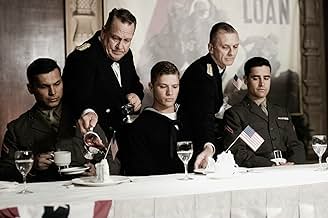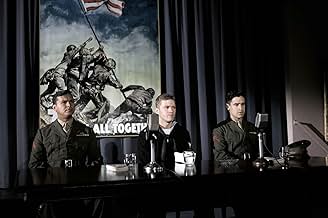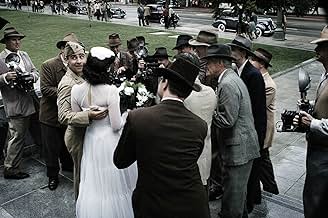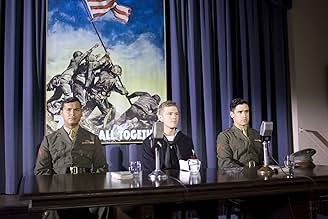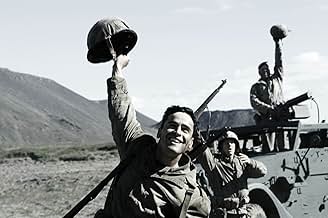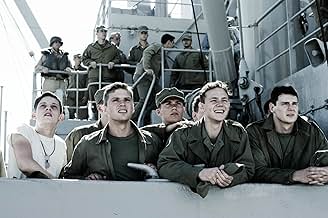Mémoires de nos pères
Les histoires des six hommes qui ont hissé le drapeau américain au sommet d'Iwo Jima, lors d'une bataille importante de la Seconde Guerre mondiale.Les histoires des six hommes qui ont hissé le drapeau américain au sommet d'Iwo Jima, lors d'une bataille importante de la Seconde Guerre mondiale.Les histoires des six hommes qui ont hissé le drapeau américain au sommet d'Iwo Jima, lors d'une bataille importante de la Seconde Guerre mondiale.
- Réalisation
- Scénario
- Casting principal
- Nommé pour 2 Oscars
- 16 victoires et 28 nominations au total
Avis à la une
(My Comment) The film was based on the book written by Doc's son, James Bradley. It wasn't until his father's death that he found out that Doc was one of the Iwo Jima flag raisers. Soldiers with real combat experiences usually keep their war stories to themselves. Clint Eastwood directed the film, and he didn't pull any punches in the battle scenes, even though the battle for Iwo Jima was considered one of the bloodiest against the Japanese in the Pacific. The only problem I had with the movie was that Eastwood used too many flashbacks that jumped around and made the movie hard to follow. The movie would have been better if Eastwood had gone in chronicle order with some flashbacks. During the battle scenes, you actually see the chaos that soldiers encounter on the battlefield. Overall, I found the story to be realistic and very compelling by not glorifying war. It is a long movie, but the time passes very fast. This film will receive many Oscar nominations. Some of the movie is graphically violent and shows the dark side of war, and the effects war has on our returning soldiers. (Warner Brothers Pictures, Run time 2:12, Rated R) (8/10)
I must admit, this one has elements of greatness in almost every department, but somehow these don't quite glue together as intended. The film seems to suffer from three evenly strong-handed approaches. The script by Paul Haggis eagerly wants to take us on an emotional roller-coaster in the second half, where the focus increasingly shifts to the story of Ira Hayes in the aftermath of the battle. There's obviously a strong hand of Steven Spielberg, who always wants to show us the human side of the story, which Clint obviously wants too, but he tends to do it in a different way. There seems to be a clash of wills, with these three major forces at work here. Ultimately, FLAGS OF OUR FATHERS is not about the war proceedings itself, but how the war affected the men who fought in it themselves, and how they refused to be seen as heroes.
It's hard to dislike any of Clint Eastwood's films and with this one, and the follow-up LETTERS FROM IWO JIMA, he made two films of epic proportions, that will undoubtedly compete for the Oscars. Both of the films that is, as they were released by different distributors, "Flags" is with Dreamworks and "Letters" with Warner Brothers.
We'll see, so far, so good. I wasn't blown away by this one, but certainly a film to respect. Difficult to judge this, before seeing the follow-up LETTERS FROM IWO JIMA, which shows the Japanese perspective of the story. I strongly suspect Clint saved the best for last and that "Letters" will be his ultimate showcase.
Camera Obscura --- 7/10
That one picture is said to be the most reproduced picture in the history of photography.
I toured Iwo Jima in 2000 with my father, a private in the 5th Marine Division, who, along with the flag raisers, landed on Iwo Jima on February 19, 1945 -- the opening day of what would be the costliest battle in the history of the U.S. Marine Corps.
I can't say enough good things about the realism of Clint Eastwood's "Flags of our Fathers." Visually, the movie made me think that I was back on Iwo Jima, and emotionally, I felt like I was witnessing what I had been told by Iwo survivors and what I had read in Richard E. Overton's "God Isn't Here: A Young American's Entry into World War II and His Participation in the Battle for Iwo Jima."
James Bradley's book "Flags of our Fathers," is wonderful, and this movie of the same name is very faithful to his book.
But, the editing of the movie takes the viewer through so many flash-backs and flash-forwards that it's hard to keep things straight -- even if you have read the book!
The movie opens with Harve Presnel (I think it was Harve) playing the role of what I thought was a narrator. Later, it looks like he's just one of many people that James Bradley interviewed for his book.
I was expecting some corny things in the movie, like seeing the flag raising picture taking up the full screen in the theater while the Marine Corps Hymn played. That didn't happen. After I heard what I thought was a narrator, I thought that anyone who didn't know what was going on in the movie would probably be kept informed of the not-so-obvious things . . . like it was Howlin' Mad Smith who was demanding, and not getting, additional bombardment of the island; like it was Secretary of the Navy, James Forrestal, who told Howlin' Mad Smith that "...the raising of that flag on Suribachi means a Marine Corps for the next five hundred years." These events were in the movie, but the characters were neither introduced by name in the movie, nor were they described by "the narrator," who seemed to come and go at odd times.
Ira Hayes is a tragic character. It's obvious that Hollywood likes tragic characters just because of all of the attention that he gets in this movie, and because Tony Curtis made a movie about Ira Hayes back in 1961. The actor who plays Ira in this movie is great!
Stephen Spielberg and Clint Eastwood obviously had to tap dance around an "Elephant in the Room" when it came to showing what happened to John Bradley's friend on Iwo Jima. If you've read the book, you know what happened. The movie does a masterful job of bringing the subject up, but not bringing it up in a manner that would offend the squeamish, or, for that matter, bringing it up in a way that would make it impossible to show the movie to a Japanese audience.
The war sequences are skillfully executed. It reminds me of the early sequences of 'Saving Private Ryan' as its shot with washed out colours and the scenes are just as visceral and hard-hitting. They are extremely effective as are the scenes where the three survivors are being paraded by officers in order to sell military bonds. The real truth is ignored, the illusion of a photo is confirmed as truth, the three soldiers are burning in the inside while obliged to parade themselves and then they are left with nothing, just memories of the war. Eastwood has also briefly but effectively tackled the racism theme. Even the label of a hero was not enough for Hayes to get a drink at a bar.
Haggis's writing is solid. War isn't glorified and the aftereffects are shown with subtlety rather than blatant preaching. The editing is tight as the movie flows at a smooth pace. It starts off with the war sequences and then follows the three surviving flag-raisers revisiting the war in flashbacks. Eastwood's soundtrack is intense and gives voice to the unspoken words. All the performances are good but it is Jesse Bradford, Adam Beach and Ryan Phillipe who stand out as the three survivors, particularly Phillipe who is restrained.
'Flags of Our Fathers' an important side of the war that almost vanished into oblivion but thanks to Eastwood and his team, many people today will know about it.
It is true that nations define themselves in large part through film and especially war films. It is true that solipsism reigns when matters of national honor are raised. This film pulls the legs from under such cheap theatrics while doing the very same thing. Its a characteristic of Eastwood that drives me crazy, how quick he is to polish ideals so they glisten next to the other guy's clichés, in this case Spielberg's "Private Ryan," which in retrospect was pretty bad storytelling.
So. Let's spank Clint for hypocrisy, for metaphorically taking the first flag. But I think much of the blame for that goes to Paul Haggis, a scourge now in full infection in Hollywood. He won't hesitate to use any device in the spine of his work, no matter how trite.
And let's wonder every time we see a war, even one like this.
But let's also give the man his due for storytelling. This is fantastic visual storytelling. Multiple narrators, multiple framing devices. Nonlinear presentation with time reversals motivated by flashbacks, memories, tales told. The business about walking 1300 miles to tell the truth, and the business about old men finally telling the truth to the son. Its what I call a folding device to underscore that we are seeing the truth, the story within the story.
The pacing is perfect, even a bit too manufactured for my taste. The most effective war film in terms of confusion and lack of theater is "Thin Red Line," I believe. The scale of the thing, both in the battles and bond events was impressive. The phrasing is tasteful, but when an episode finished, I couldn't help but be aware that I was being sold an image I was expected to wear.
Its enough to drive me to drink.
Ted's Evaluation -- 2 of 3: Has some interesting elements.
Le saviez-vous
- AnecdotesThe story about the flag raising being posed was true. It was started, ironically, by Joe Rosenthal. He did not know he had taken the famous photograph until he returned to the States. He did, however, take a second photograph of the five Marines and one Navy Corpsman gathered around the flag. When people asked if he had posed the photograph, he, thinking they were referring to the second photograph said "Of course". It was only after seeing the first photograph that he realized they were referring to that photograph and not the second one.
- GaffesIn explaining the importance of a successful bond drive, the treasury representative says that the fuel dumps are empty and "our Arab friends only take bullion." At the time of World War II, America was essentially self sufficient in oil production and not dependent on Arab oil. While oil was discovered in some Arab countries before the war, it was not extensively developed until after the war.
- Citations
[last lines]
James Bradley: I finally came to the conclusion that he maybe he was right. Maybe there's no such thing as heroes. Maybe there are just people like my dad. I finally came to understand why they were so uncomfortable being called heroes. Heroes are something we create, something we need. It's a way for us to understand what's almost incomprehensible, how people could sacrifice so much for us, but for my dad and these men, the risks they took, the wounds they suffered, they did that for their buddies. They may have fought for their country but they died for their friends. For the man in front, for the man beside him, and if we wish to truly honor these men we should remember them the way they really were, the way my dad remembered them.
- Crédits fousThere is an additional short sequence after the credits have ended.
- Bandes originalesKnock Knock
Written and Performed by Kyle Eastwood, Michael Stevens, Andrew McCormack and Graeme Flowers
Meilleurs choix
- How long is Flags of Our Fathers?Alimenté par Alexa
- Is "Flags of Our Fathers" based on a book?
- How does "Flags of Our Fathers" relate to "Letters from Iwo Jima"?
- Where exactly is Iwo Jima?
Détails
- Date de sortie
- Pays d’origine
- Sites officiels
- Langue
- Aussi connu sous le nom de
- La conquista del honor
- Lieux de tournage
- Sociétés de production
- Voir plus de crédits d'entreprise sur IMDbPro
Box-office
- Budget
- 90 000 000 $US (estimé)
- Montant brut aux États-Unis et au Canada
- 33 602 376 $US
- Week-end de sortie aux États-Unis et au Canada
- 10 245 190 $US
- 22 oct. 2006
- Montant brut mondial
- 65 900 249 $US
- Durée2 heures 15 minutes
- Couleur
- Mixage
- Rapport de forme
- 2.39 : 1
Contribuer à cette page








